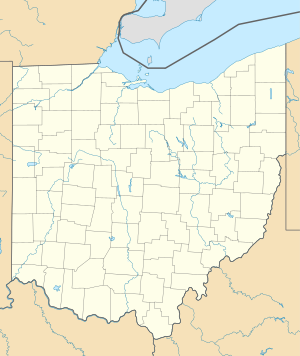Battle of the Wabash River
| date | November 4, 1791 |
|---|---|
| place | near Fort Recovery , Ohio |
| output | Indian victory |
| Parties to the conflict | |
|---|---|
|
allied Indian tribes of the Northwest Territory |
|
| Commander | |
|
Little Turtle |
|
| Troop strength | |
| more than 2,000 (estimate) | around 1,400 soldiers and militiamen; numerous drivers and other civilian personnel including women |
| losses | |
|
allegedly only around 60 dead and wounded |
over 600 dead soldiers and militiamen; |
Battle of the Wabash River |
The Battle of the Wabash River (English: Battle of the Wabash ), also known as St. Clair's Defeat ( St. Clair's Defeat ), was on November 4, 1791 near Fort Recovery in what is now Ohio ( Mercer County , Gibson Township) carried out. A US armed forces led by General Arthur St. Clair , a veteran of the American Revolutionary War , suffered a devastating defeat against an alliance of Indian tribes, whose leaders u. a. the chiefs were Little Turtle and Blue Jacket . The battle is one of a series of military defeats that the US Army initially suffered in the so-called war against the Northwest Indians ( Northwest Indian War ). It was one of their bloodiest military defeats against Indians. Around 620 soldiers and 60 Indians died in the battle.
procedure
St. Clair's army, which consisted of experienced soldiers, recruits and militiamen and numbered over 2,000 men at the beginning of the campaign, advanced in early October 1791 against the Indians, who had inflicted heavy losses on General Josiah Harmar's (1753–1813) forces the year before . After an excruciatingly slow advance, St. Clair's troops reached the Indian settlement areas on the Wabash River about a month later . The US armed forces, which were poorly equipped and poorly disciplined from the start, had meanwhile shrunk to around 1,400 men. Many of the men simply went home at the end of their service hours, others deserted . This situation was made worse by St. Clair's poor health: repeated attacks of gout made it nearly impossible for him to be in command; often it had to be carried on a stretcher.
On November 3rd, the soldiers camped on both sides of a tributary of the Wabash River, where they were attacked by the Indian warriors at dawn the following day. The battle, which lasted about three hours, brought the US Army the greatest defeat it has ever suffered in a fight against Indians. More than 600 militiamen, soldiers and officers were killed, plus a not inconsiderable number of car drivers, sutlers and women who had accompanied St. Clair's men.
consequences
For the young United States, St. Clair's defeat meant a serious setback in the fight against the Indian tribes of the Northwest Territory . It was not until 1795, after the Indians had lost the Battle of Fallen Timbers in the summer of 1794 , that the changeable battles were decided in favor of the United States. With the Treaty of Greenville , the Indians were forced to cede them a considerable part of their ancestral settlement area.
literature
- Calloway, Colin G .: The Victory with No Name. The Native American Defeat of the First American Army . Oxford University Press, Oxford and New York 2014, ISBN 978-0-19-938799-1 .
- Josephy, Alvin M .: 500 Nations. The Illustrated History of the Indians of North America . Frederking & Thaler GmbH, Munich 1996, ISBN 3-89405-356-9 .
- Mattioli, Aram , Lost Worlds - A History of the Indians of North America, Stuttgart 2017, from p. 90, ISBN 978-3-608-94914-8 .
- Tucker, Spencer C .: Battles That Changed American History: 100 of the Greatest Victories and Defeats . ABC-CLIO, 2014, ISBN 9781440828621 , pp. 73-75
- novel
- Woolard, Jim R .: Blood at Dawn . Berkley Books, New York 2001, ISBN 0-425-17861-7 .
Web links
- St. Clair's Defeat at Ohio History Central (English)
- Saint Clair's Defeat in the Encyclopædia Britannica (English)
Individual evidence
- ↑ Wilcomb E. Washburn (Ed.): Handbook of North American Indians . Vol. 4: History of Indian-White Relations. Pp. 149-152.
Coordinates: 40 ° 21 '26 " N , 84 ° 45' 46" W.

